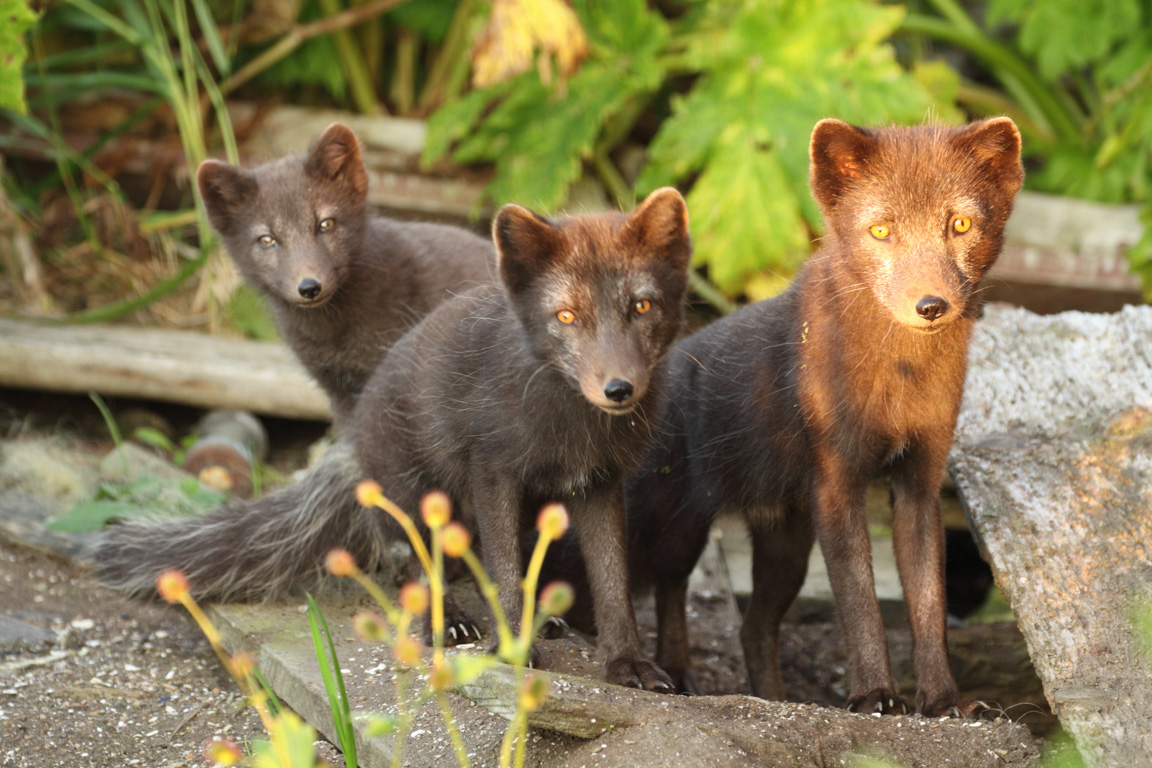The arctic fox plays one of the defining roles in the ecosystem of the Commander Islands. Before the discovery of the archipelago in 1741, the beast was the only terrestrial inhabitant that interacted with the local avifauna and marine mammals. Later, when invasive species settled on the island, the influence of the arctic fox spread to the red vole, American mink, and even reindeer.
Why and how endemic populations of the Bering and Mednovsky arctic foxes are studied in the reserve? What is the difference between them and how to save them? You will find the answers here.
Counts as the main way to observe fox populations
Alexander Shienok, Ph.D., senior researcher of the nature reserve and lecturer at Moscow State University Lomonosov, has been studying Arctic foxes on the Commander Islands for more than 15 years. Research is being carried out under the Environmental Monitoring Program to collect data on the state of populations of various species of protected animals and plants, including two endemic subspecies of the arctic fox on Bering and Medny.
“About 12 thousand years ago, when the ice between the islands finally melted, the connection between the two populations broke up,” he says. “Since then, each has evolved in its own way, and today the Mednovsky arctic fox is threatened with extinction, while the position of its Bering relative looks better at first glance.”
In the mid-1970s, Mednovsky arctic foxes were struck by ear scabies, and their number dropped sharply to a critical level of 120-150 adults. Since then, the subspecies has been under the scrutiny of scientists, in 1983 it is included in the Red Book of the Russian SFSR, in 1997 it is in the Red Book of Russia, and in 2006 it is listed in the Red Book of Kamchatka.
“Although the number of Bering arctic foxes is within the normal range from 400 to 500 individuals, no one can guarantee that the same thing as on Medny will not happen to them. Therefore, we need to regularly monitor the state of both populations in order to notice a dangerous decrease or, conversely, an increase in the number of animals in time. So, thanks to the counts, we will be able to know in advance about a new epidemic,” says Alexander.
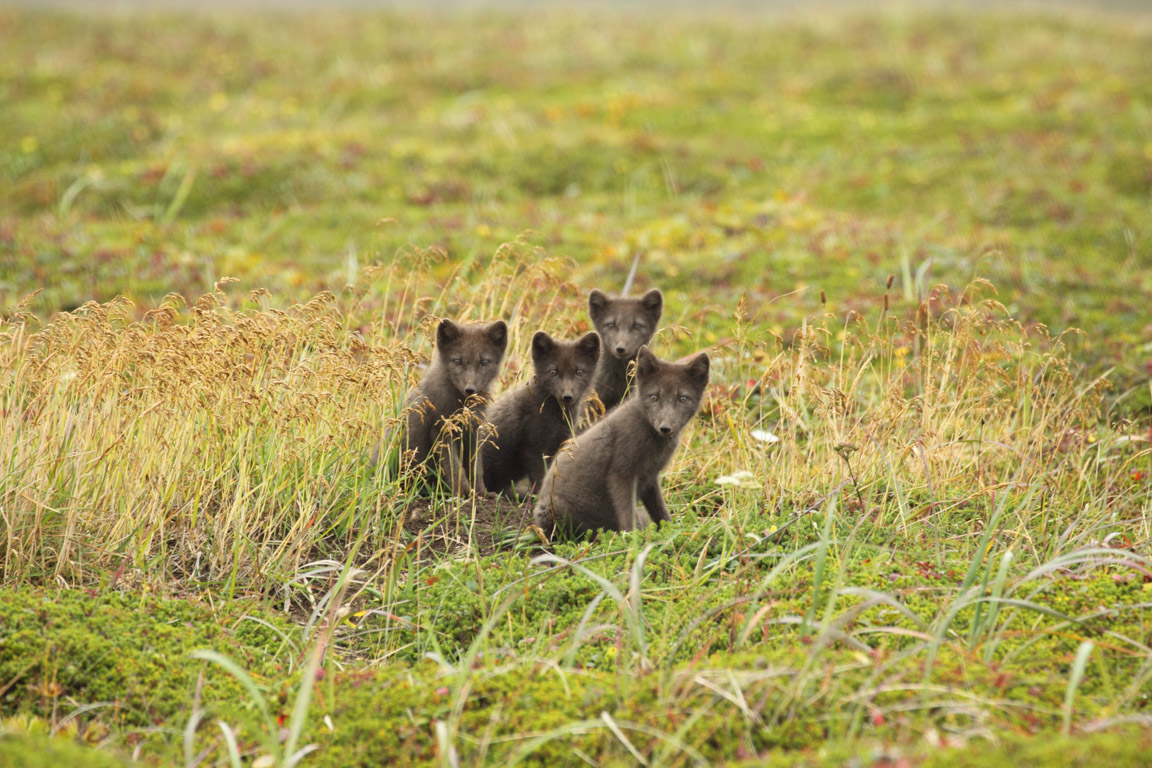
Litter of arctic foxes. Photo by Alexander Shienok
Monitoring of arctic foxes on Bering Island is annually held in two stages. In early spring, scientists count foxes, circling the territory on snowmobiles. In summer, experts observe newly born puppies. According to the number of litters and the state of health of the puppies, it is possible to predict whether the population will remain stable or an epizooty will await it.
Epizooty in Mednovsky arctic foxes and its consequences
Scabies claimed most of the Mednovsky arctic fox population. Only the strongest animals survived, which did not develop immunity but at least adapted to the disease. The animals failed to completely get rid of the ear tick, and annually some of the puppies do not survive because of this parasite.
To help the arctic foxes fight the disease, the reserve, with the financial support of WWF Russia, has developed an animal health program. In 2012, in the south of Bering Island, where lives about half the population, specialists caught sick puppies and treated them with the Pfizer Stronghol antiparasitic drug.
“Then we caught the treated animals again and did not find an ear tick on them. At least there is a short-term effect of getting rid of parasites. However, in order to get rid of of the disease in the whole population, ideally it is necessary to catch and treat all the members of each arctic fox family and their dens, which is almost impossible, ”Alexander explains.
In the wake of parasites
Parasites affect animal health and population dynamics. In the case of the Mednovsky arctic fox, epizooty is a consequence. And its reason is reduced immunity. Based on this, animals can have problems not only with scabies or other infectious diseases, but also with dangerous internal helminths. A similar situation is possible in the population on Bering Island, which is subject to fluctuations in numbers. Perhaps a periodic deaths among the local population is also associated with endoparasites.
One way or another, the Bering arctic fox interacts with all the inhabitants of the island due to food or life in common biotopes. Thus, scientists simultaneously explore the red field vole (one of the main sources of food for animals) and the American mink, with which the arctic fox intersects on the coast and in the valleys of rivers and lakes.
%20у%20песцовой%20норы.jpg)
Alexander Shienok counts the remnants of food in the arctic fox den. Photo by Irina Chilchigesheva
The easiest way to find out what an arctic fox eats is to examine the remains of food in its den. Having counted the wings of birds, we can say which feathered inhabitants of the island it eats more often and in what quantity. A deeper method is to examine the feces and parasites of animals, since they can get some helminths only from strictly defined animals. For example, uncinariosis, which causes death in puppies of the northern fur seal. It turned out, this parasite is also common among arctic foxes, causing mortality in young animals. The animal can become infected by it in the center of seals distribution on the sand rookery, but even at the same time it can be an agent, trnsporting it along the beaches.
The most common parasite of the Bering arctic fox is Diphyllobothrium tapeworm . This suggests that the nutrition of the Arctic fox largely depends on the fish. Consequently, the welfare of the population depends on the conservation of fish resources on Bering Island. But we need to remember that salmon obtained in local waters must be specially processed and not eaten raw.
“Given that the Arctic fox is in contact and eats everything that lives on the island, we can use it to judge the helminth fauna in Bering Island. So, according to the analysis, we found that here you can get infected with various nematodes like hookworms and toxocars from dirty soil,” the researcher said.
Habitat protection is the key to species conservation
Annual surveys of the Bering arctic fox give up-to-date information on its abundance and, importantly, on how it is distributed throughout the island, where it builds dens more often, and where less often. By comparing this information with the data on nearby forage resources - spawning rivers, rookeries, bird colonies - you can find out what conditions and sites are most favorable for breeding animals.
“In addition to protecting the animal itself, it is first necessary to protect its environment. And if we know that at some site the population of arctic foxes is well restored, then we must pay attention to the biological resources through which they survive. For example, you can ban hunting a tiger. But while allowing to cut down forests and shoot wild boars, we can’t save the species, it will starve to death. ”
Arctic fox den is not just a house
Den is a part of the arctic fox information network. The whole life of animals is built around dens and systems of paths connecting them. Sometimes the age of these formations can reach hundreds of years. You can determine how old the den is and how often arctic foxes populate it, by its structure: a large number of chambers and the surrounding vegetation.
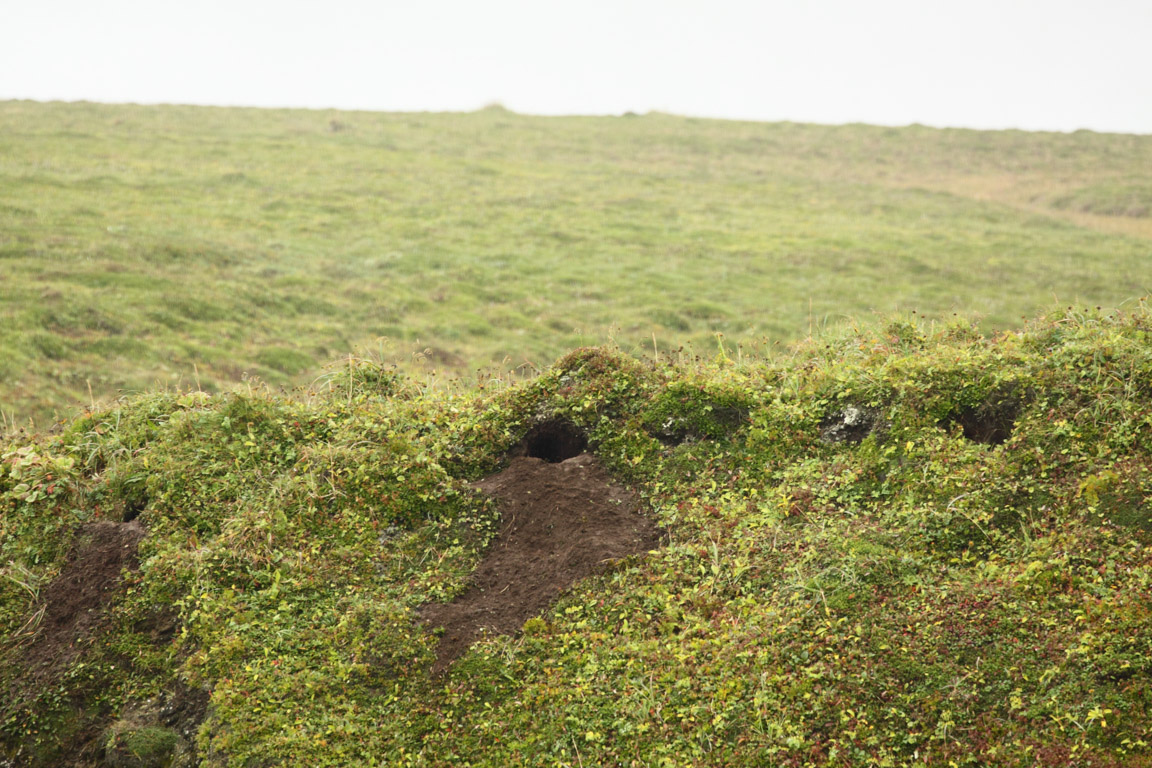
Arctic fox den. Photo by Alexander Shienok
Dens are often located away from the coast. There, foxes leave leftovers of food, fertilizing the tundra. As a result, the surrounding area is overgrown with grassy vegetation. This grass stain remains for a long time, even if arctic foxes abandon the den.
In fact, arctic foxes act as ecosystem designers, creating a breeding ground for small birds and even reindeers around their homes. Ungulates often come to arctic fox dens to eat mineral-rich land or to pinch grass, which grows here in the spring earlier than in other areas.
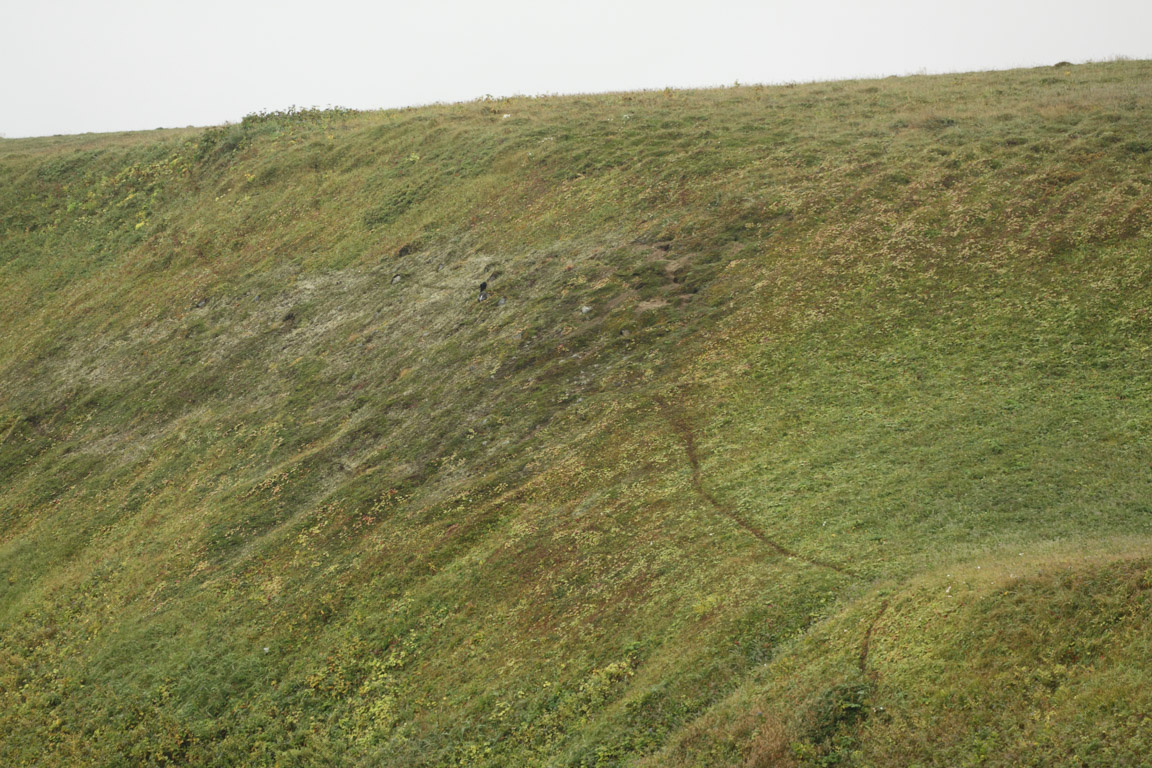
The path leading to the fox den. Photo by Alexander Shienok
“Separate dens are visible even from a satellite. Luminous spots in the image show rugged vegetation, and in the case of the Bering or Medny islands, arctic fox dens can be found at these points. In a number of cases, I really found dwellings of arctic foxes there. It turns out that you can also find a fox den from a satellite image - not the main, but a useful way of monitoring,” said Alexander.
The reasons for the fluctuation in numbers are still unknown.
The number of pups in the litters of Bering arctic fox has remained stable over the past years with the exception of two periods. In 2012, researchers noticed that the number of newborn puppies fell markedly and suggested that the population was in danger. Nevertheless, the next year there was a surge in numbers, and since then the indicators have changed only in 2018: then Alexander Shienok again noticed a fall. It is curious that this happened only in the north, and in the south the litters were not affected.
Last year, the number of litters was high, including in the north. “So far, it remains a mystery to us about the failures and surges in the birth rate. The reason may be in feed, weather, helminths. Or it’s about self-regulation: having reached a peak in numbers, arctic foxes stop breeding,” says Alexander.
As for Mednovsky, the population is not declining, but it is not growing, remaining at a stable low level. In recent years, the reserve again keeps records of Mednovsky arctic foxes together with the biological faculty of Moscow State University, which allows to cover the entire island and obtain accurate data. Last summer, in addition to Alexander Shienok's work, the group of Anton Pletenev’s university researcher worked on Medny Island. According to observations, the puppies left the holes quite late, there were few broods, but within the usual range there is no reason for concern.
Can hunting maintain a normal population?
The hunt for the Bering arctic fox was carried out until as late as the 2000s, after which it gradually ceased and natural regulation of the number of animals began. Some hunters fear that without being hunted, the arctic fox is in the same danger as its brother on Medny. There, hunting was abruptly stopped back in the 1960s, the numbers increased rapidly, and then there was a sharp decline. There is an assumption that the number of animals exceeded the permissible threshold, after which the animals began to exchange the scabies mite and become ill on a massive scale.
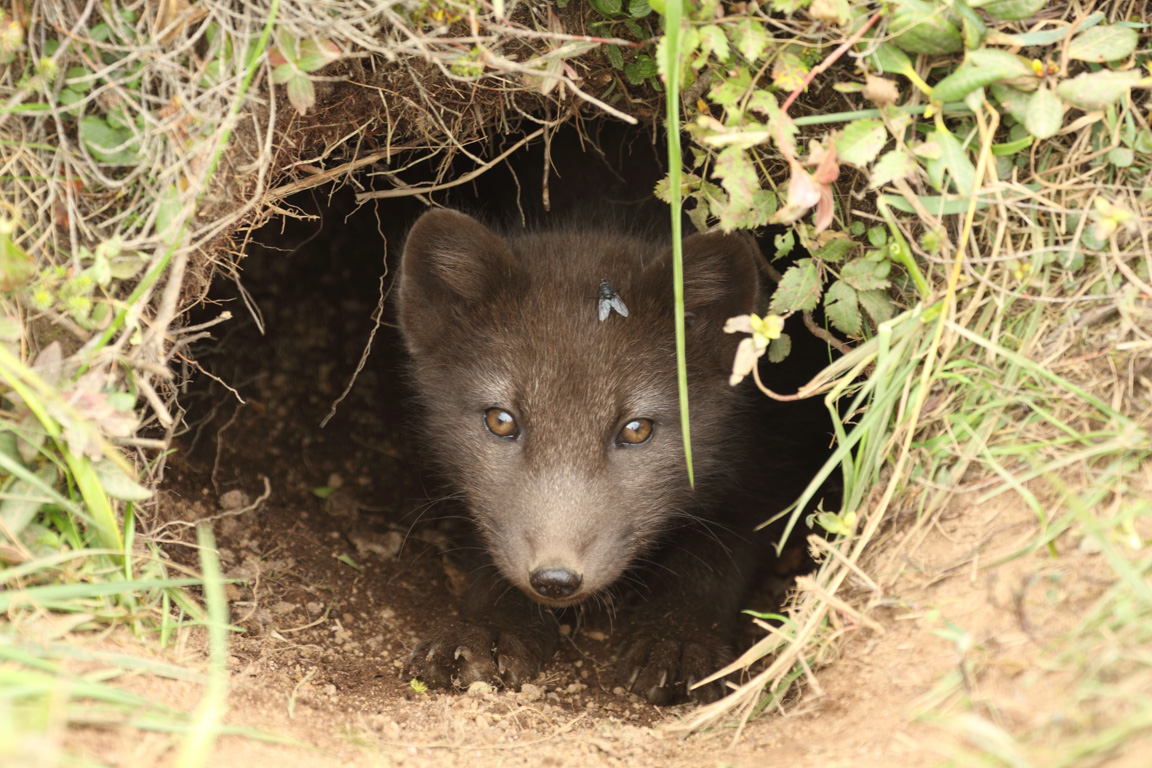
A fox puppy looks out of a den. Photo by Alexander Shienok
“It is a little naive to think that without hunting the number of arctic foxes will fall. After all, they existed nicely for thousands of years without hunters. Firstly, the number of individuals and genetic diversity on Bering Island is higher than on Medny, and secondly, hunting here was reduced gradually, allowing the animals to adapt to new conditions. Apparently, everything will be fine with the Bering population, but you need to keep an eye on it, remembering the sad experience on Medny,” Alexander concluded.
Research of arctic foxes will resume in spring 2020. Researchers will have to count the number of animals again and take the necessary samples to assess the health of the population of the true aborigines of the Commander Islands.









